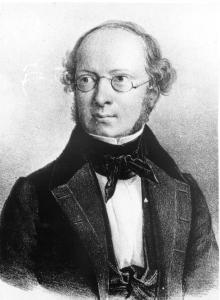Alexander von Bunge (botanist)
Alexander Bunge ( Russian Александр Андреевич Бунге / Alexander Andrejewitsch Bunge * September 24 jul. / 6. October 1803 greg. In Kiev , † July 6 jul. / 18th July 1890 greg. In Kiltsi , community Väike-Maarja , Estonia Governorate ) was a German-Russian botanist , traveler and doctor . Its official botanical author's abbreviation is " Bunge ".
Live and act
Bunge came from the Kiev pharmacist family , which is derived from Georg Friedrich Bunge . His older brother Friedrich Georg von Bunge became a legal historian and is considered the founder of Baltic legal history.
From 1821 he studied medicine and botany at the University of Dorpat (now Tartu). In 1825 he completed his medical studies and received his doctorate. In 1826 he toured the Altai Mountains with Carl Friedrich von Ledebour , where he continued to travel until he reached the Katun springs in 1829 . The research results of this trip are in “ Karl Friedrich v. Ledebour's journey through the Altai Mountains and the Djungarian Kyrgyz steppe … ”(Berlin 1829–30). He played an important part in Ledebour's publications “ Flora altaica ” (1829–33) and “ Icones plantarum novarum vel imperfecte cognitarum floram rossicam, imprimis altaicam, illustrantes ” (1829–34).
In 1830 he accompanied the new spiritual mission sent to China as a natural scientist and studied the flora of the Gobi steppe and the surrounding area of Beijing . From this trip he returned to Russia in 1831. He published his results in the works Enumeratio plantarum, quas in China boreali collegit (Petersburg 1831) and Plantarum mongholico-chinensium decas I (Kazan 1835).
In 1832 he traveled to the Altai Mountains again to examine the flora of the eastern part of the Altai.
In 1834 he became professor of botany in Kazan . From there, he traveled in 1835, the Volga steppe south to the province of Astrakhan .
In 1836 he went to Dorpat, where he became professor of botany and director of the botanical garden.
In December 1857 he joined the scientific expedition to investigate Khorasan , which took him to Afghanistan , among other places . From Gorgan he visited Shahrud , Nishapur , Maschhad and Herat and in 1858 made a long excursion to the eastern edge of the great salt desert to Tebbes . In February 1859 he started his return journey via Lasch through the salt desert to Zabulis , Kerman , Isfahan , Tehran , Tabriz and Tbilisi and returned in August 1859 to Dorpat, where he devoted himself to the processing of his botanical harvest.
In 1868 Bunge retired. He died in Mõtliku near Ass Castle in Kiltsi village in 1890 and was buried in Dorpat .
Specialties
In particular, Bunge dedicated two monographs to the species-rich genera Astragalus tragacanth and Oxytropis ( pointed keel ) from the legume family . Bunge's work Species generis Oxytropis DC , published in Saint Petersburg in 1874, lists 181 different pointed keel species in 4 subgenera and 19 sections. To date, this monograph, with a previous one by De Candolle, is the only one that considers the genus in global terms and is therefore still the standard work in the taxonomic description of the genus and the individual species.
Honors
A Martian crater and the bungeland are named after Bunge . The plant genus Bungea C.A.Mey. from the family of Broomrape family (Orobanchaceae) is named after him.
relationship
Alexander von Bunge was married twice. With his wife Wilhelmine Amalie, nee Schreiber, he had the daughter Marie Elisabeth (1834-1909).
The children come from the second marriage with Caroline Elisabeth (1813-1858), née von Pistohlkors:
- Gustav (1844–1920), physiologist and professor at the University of Basel ,
- Elisabeth, wife of the painter Eugen von Ruckteschell (1850–1928),
- Alexander (1851–1930), doctor, explorer and zoologist.
Works
- Enumeratio plantarum, quas in China boreali collegit… , Petersburg 1831
- Plantarum mongolica-chinensium decas prima , Kazan 1835
- ... Tentamen generis Tamaricum species accuratius definiendi , Dorpat 1852
- Anabasearum revisio , Petersburg 1862
- Generis Astragali species gerontogeae , Petersburg 1868–1869; 2 parts
- Labiatae persicae , Petersburg 1873
literature
- Ludwig Stieda: Bunge, Alexander von . In: Allgemeine Deutsche Biographie (ADB). Volume 47, Duncker & Humblot, Leipzig 1903, pp. 362-364.
- Bunge, Alexander, traveler . In: Meyers Konversations-Lexikon 1891-1892, Volume 19 / Supplement, page 132
- Werner Hilbig: Alexander von Bunge (1803–1890), an important researcher of the Mongolian flora (PDF; 291 kB). In: Schlechtendalia 25, 2013, pp. 3–12.
Web links
- Author entry and list of the described plant names for Alexander von Bunge (botanist) at the IPNI
- Biography in the Russian encyclopedia Brockhaus-Efron
- Album academicum of the Imperial University of Dorpat , Dorpat 1889
- Article Alexander von Bunge (botanist) in the Great Soviet Encyclopedia (BSE) , 3rd edition 1969–1978 (Russian)
- Baltic Historical Commission (ed.): Entry on Alexander von Bunge. In: BBLD - Baltic Biographical Lexicon digital
- Personal collection with digitized works University of Tartu
Individual evidence
- ^ Digital copy on the page of the Bayerische Staatsbibliothek [1]
- ↑ Seer KARAMAN ERKUL, Zeki AYTAÇ 2013: The revision of the genus Oxytropis ( Leguminosae ) in Turkey. Turkish Journal of Botany, 37: 24-38.
- ↑ Lotte Burkhardt: Directory of eponymous plant names . Extended Edition. Botanic Garden and Botanical Museum Berlin, Free University Berlin Berlin 2018. [2]
| personal data | |
|---|---|
| SURNAME | Bunge, Alexander von |
| ALTERNATIVE NAMES | Бунге, Александр Андреевич (Russian) |
| BRIEF DESCRIPTION | German-Russian doctor and botanist |
| DATE OF BIRTH | October 6, 1803 |
| PLACE OF BIRTH | Kiev |
| DATE OF DEATH | July 18, 1890 |
| Place of death | Kiltsi , Väike-Maarja , Estonia Governorate |
